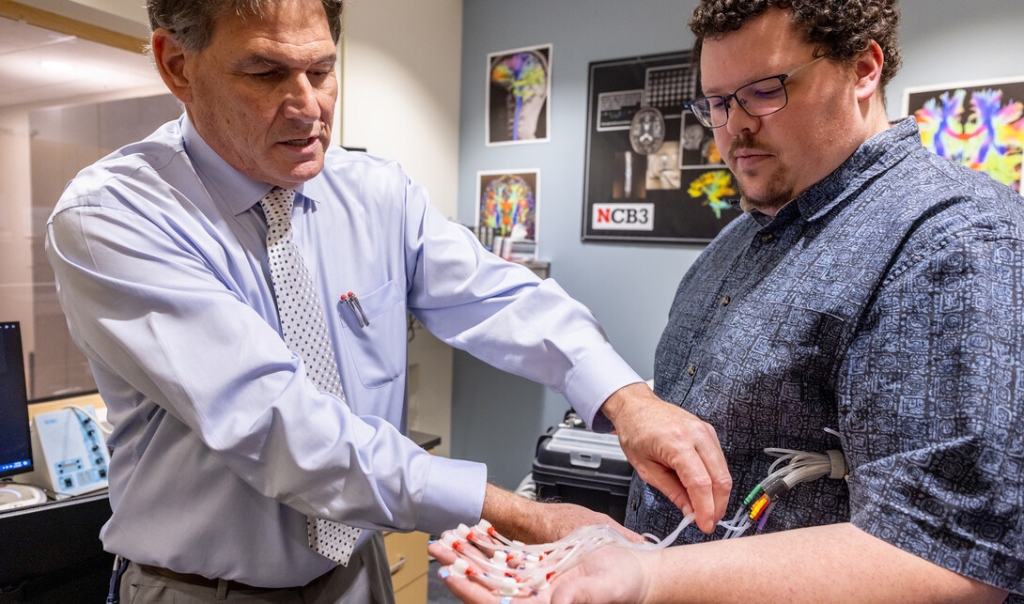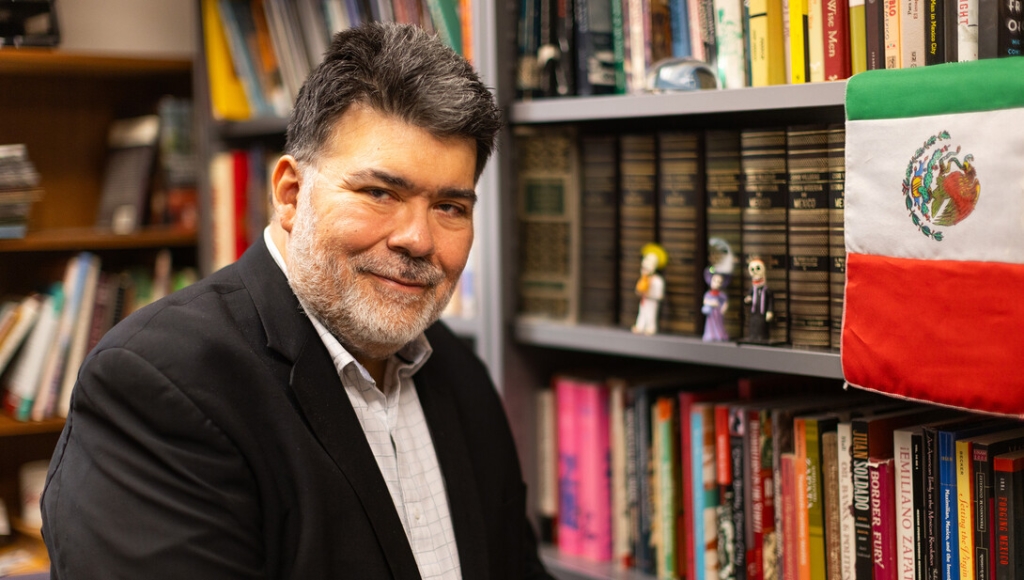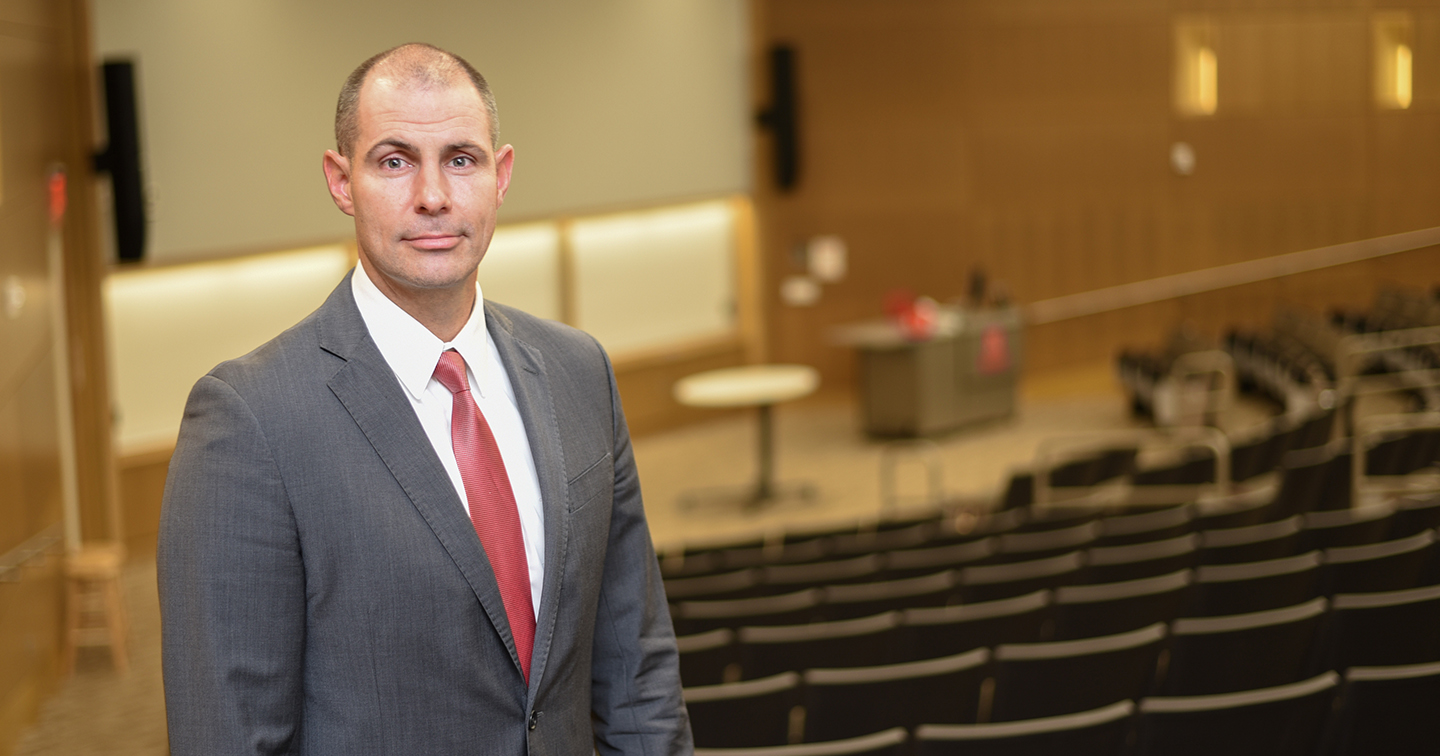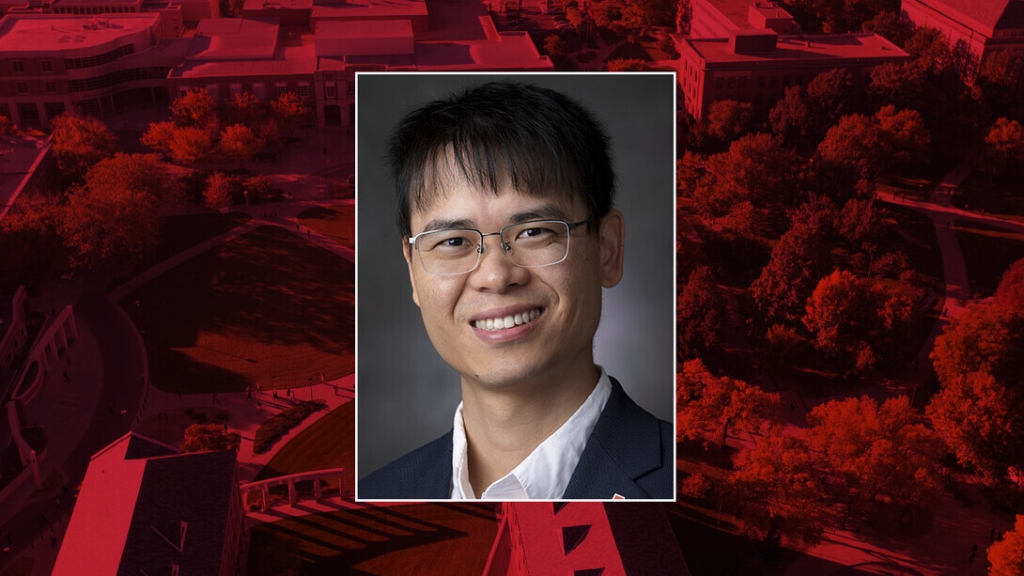Posted April 4, 2025 by Tiffany Lee
In case you missed these stories highlighting research and creative activity at the University of Nebraska-Lincoln, the Office of Research and Innovation’s communications team has compiled a roundup of some top research stories from research.unl.edu and other sources.

Spider Sense: Study tracks how web-building arachnids adapt to noise
Who: Eileen Hebets, George Holmes Professor of biological sciences; Brandi Pessman, postdoctoral researcher in biological sciences
What: Hebets and Pessman published an article, which was covered in The New York Times, demonstrating that the webs of funnel-weaving spiders transmit vibrations differently in response to local environmental noise. The results suggest that spiders may intentionally spin their webs differently to manage surrounding noise and receive crucial sensory information. The study also shows that the webs function differently depending on whether the spider came from an urban or rural environment, raising the possibility that a spider’s past exposure to environmental noise – and possibly its genetic makeup – shapes its web-building flexibility. Urban spiders built webs that quieted their environment, likely a means for avoiding excessive stimulation and enabling precise detection of prey. Rural spiders “turned up” their web volume under loud noise conditions – possibly to amplify incoming noise to better discern certain signals.
“This study really highlights the role of receivers in overcoming environmental noise,” Hebets said. “It opens up entirely new avenues of research. For example, are receivers placing themselves at certain locations in the environment where signals are going to receive less attenuation or overlap of noise? Even without being able to go into the nervous system, other people can start looking at ways that receivers might be adjusting to increase the relevant signal-to-noise ratio.”
Writer: Tiffany Lee, Office of Research and Innovation

Barlow patents groundbreaking frontline stroke treatment
Who: Steven Barlow, Corwin Moore Professor in special education and communication disorders, affiliate faculty in biological systems engineering and resident faculty in the Center for Brain, Biology and Behavior; Jacob Greenwood, doctoral candidate in biomedical engineering
What: Barlow and Greenwood have patented a groundbreaking frontline treatment for stroke, a leading global health issue. The pTACS Somatosensory Biomedical Device is low-cost and portable, making it a versatile product for use in rehabilitation clinics, emergency rooms and, potentially, transport ambulances. The device is a non-invasive method of brain stimulation and works by sending rapidly compressed air pulses through small plastic tubes into thermoplastic tactile “touch” capsules adhered to the hands, face, feet or other area of the skin. This stimulation evokes repeated volleys of nerve responses, increasing blood flow in tissues of the cerebral cortex near damaged areas of the brain. This could potentially save brain cells from death, preventing the formation of cerebral infarct. Barlow expects the device to have more therapeutic uses in the future, including possibly for speech-language therapy functions.
“It’s got a really good trajectory,” he said. “And we have a vibrant team. We have a lot of investigators, and many students interested in this.”
Writer: Deann Gayman, University Communication and Marketing

Garza uncovers untold stories behind Mexico City’s transformation
Who: James Garza, associate professor of history and ethnic studies
What: Garza is nearing completion of a book focused on how the Mexican government, at the end of the 19th century, partnered with a major British engineering firm to build a 30-mile drainage canal outside Mexico City. A major engineering triumph, the Gran Canal del Desagüe provided flood control, improved sanitation and made Mexico City one of the world’s largest and most beautiful metropolitan areas. But its construction also destroyed most of the marshy lakes that once bordered Mexico City, eliminating the birds, fish, plants and insects foundational to indigenous people in the area. Garza’s book – which is under contract with the University of Nebraska Press and is expected to be published in 2026 – will explore these long-term impacts of wetland disappearance.
“I’m trying to capture this episode in the transformation of the world from the way it was at the dawn of the 20th century,” Garza said. “At the end of the 19th century and at the early 20th century, there still were glimpses of a way of life that had existed for centuries. The lakes were a source of life for the rural people, a source of food and building materials, hunting and fishing. All of that is gone now, that way of life.”
Writer: Leslie Reed, University Communication and Marketing

Project broadens horizons for preservice teachers, middle school students alike
Who: Jillian Harpster, assistant professor of practice in teaching, learning and teacher education
What: Harpster led a project that helped preservice teachers broaden their practical experiences with students, with the overall goal of positioning them for long-term success in the classroom. The project also enabled seventh- and eighth-grade students to engage in the college experience. Supported with funding from the Office of Research and Innovation’s Research Faculty Seed Grant program, students in Harpster’s “Literature of Adolescents” course worked with middle schoolers from Park Middle School, a Title I school in Lincoln, during book clubs. Findings showed that the preservice teachers gained confidence in their teaching methods and in engaging with students. Harpster said experiences like these can help preservice teachers overcome doubts about their abilities, which usually creep in between students’ practicum and their teaching year.
“These findings show us that if we can speed up that valley of doubt – basically, take a shortcut past that feeling of despair, with more supports and structures in place – then it sets them up for growth earlier once their solo teaching careers begin.”
Writer: Chuck Green, Nebraska Center for Research on Children, Youth, Families and Schools

Nebraska undergrads uncover ancient secrets of human immunity
Who: Avery Marquis and Vanessa Hubing, Husker undergraduate students; Chanasei Ziemann, recent UNL graduate; Luwen Zhang and Etsuko Moriyama, professors of biological sciences
What: In a rare feat for undergraduates, three Husker students are first authors of two recently published research articles that report significant findings about the evolution of human immune systems. Marquis, Hubing and Ziemann – all participants in the university’s Undergraduate Creative Activities and Research Experience program – conducted research exploring how interferon regulatory factors, or IRFs, orchestrate innate immune system and inflammatory responses. In one study, they traced how vertebrate organisms developed more sophisticated immune regulation when they evolved to acquire jaws. In another, they described how a “pseudogene” – a gene that does not make a protein – may have helped give human ancestors an edge against certain germs. Under Zhang and Moriyama’s mentorship, the students gained experience with cutting-edge technology, which they said will benefit them as they pursue careers in science and health care.
“Everyone out there is thinking you need to go to an Ivy League school for this,” Ziemann said. “It’s cool that this level of research is done in Nebraska.”
Writer: Leslie Reed, University Communication and Marketing

Study explores companies trapped by quarterly earnings forecasts
Who: Sam Melessa, associate professor of accountancy
What: Melessa is co-author on a recent study exploring how external market pressures keep public companies locked into issuing quarterly earnings forecasts, even when the practice encourages short-term thinking over long-term growth. Melessa’s team investigated whether firms continue to provide quarterly earnings predictions out of fear that investors would lower the company’s stock price if they stopped. The researchers looked at firms that suspended quarterly forecasts because of the COVID-19 pandemic, but then never resumed the practice. Unlike firms that stopped guidance in the past and often saw their stock prices drop, the researchers found that the companies that stopped due to the pandemic continued to perform well afterward. This indicates the decision was not due to expected poor performance, but instead was a chance to escape a practice the company felt pressured to continue.
“Our findings suggest that many firms get ‘stuck’ providing guidance because they fear negative market consequences if they stop,” Melessa said. “The COVID-19 crisis temporarily removed this fear, allowing firms to reassess their disclosure strategies.”
Writer: Sheri Irwin-Gish, College of Business

Fellowship will advance Liu’s wireless network research
Who: Qiang Liu, assistant professor of computing
What: With support from the National Science Foundation and its Established Program to Stimulate Competitive Research Fellows initiative, Liu is collaborating with Iowa State University researchers to develop autonomous mobile 6G networks. He will design novel artificial intelligence and machine learning techniques to address real-world network management challenges such as safety, scalability, robustness and practicality. Liu said Iowa State’s unique city-scale network infrastructure, which includes several base stations throughout the city of Ames, is advantageous to his research because the setup generates more wireless interference – a problem his work aims to mitigate. Liu will apply what he learns at Iowa State to expand his work on Husker-Net, UNL’s private 5G network.
“Interference management is one of the big issues of wireless networks,” Liu said. “With this unique infrastructure, we can test interference and make sure that our AI machine learning model is learning, and we can apply that to a city-scale model rather than a lab-scale model.”
Writer: Victoria Grdina, School of Computing

Huskers help youth navigate online media landscape
Who: Guy Trainin, professor of education in the Department of Teaching, Learning and Teacher Education; Kristen Friesen, graduate student in teaching, learning and teacher education; Sam Bendix, media arts specialist in the Johnny Carson Center for Emerging Media Arts; Megan Elliott, Carson Center director; Lindsey Clausen, project manager for Edgeworks at the Carson Center
What: Huskers from the College of Education and Human Sciences and the Carson Center collaborated to create an educational curriculum focused on helping youth develop online media literacy, a kind of driver’s ed for navigating the digital landscape. The curriculum guides include activities, worksheets and further reading to reinforce themes from the Media Stamped video series, which is produced by education and advocacy organization Global Citizen. The series, aimed at pre-teens, has episodes on topics like screen time and how what people see and hear online affects perceptions. Friesen developed the curriculum guides and Bendix designed them. Next, the team would like to create a curriculum for parents, who grew up in an environment very different than their children’s. The project is an example of collaboration between departments at UNL and with an external partner.
“The digital world is a real world,” Trainin said. “Things are happening there. You have conversations there. Some people work there. The lesson plans connect it with the rest of the world. These things have ramifications beyond the digital world.”
Writer: Kristina Jackson, University Communication and Marketing





